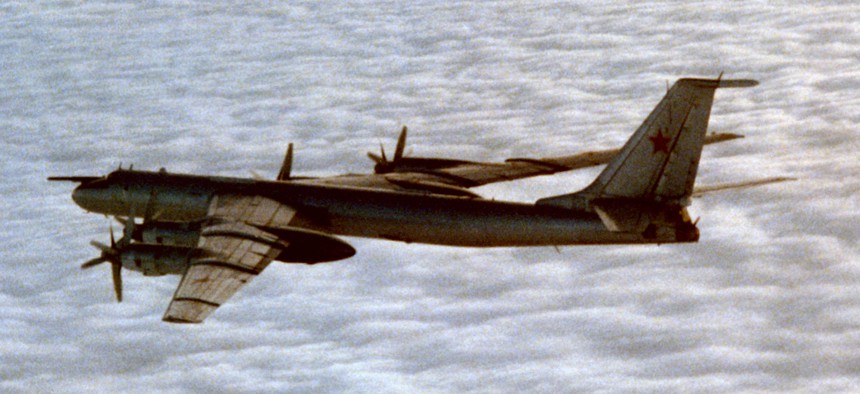
"Top Gun" came out in 1986, the same year the U.S. Navy photographed this Soviet Tu-142 maritime patrol aircraft — the same type that recently flew past the USS Ronald Reagan. U.S. Navy
Expect the Russians to Keep Buzzing American Navy Ships
Cold War-era tactics resurface at sea, but this time, Moscow’s ultimate intentions are unknown.
In the opening dogfight of “Top Gun,” a sailor stares at a radar screen, nervously calling out the distance of fictitious MiG-28 fighter jets challenging Tom Cruise in his F-14 Tomcat. His commander watches the foreign aircraft edge closer to his carrier, and finally barks, “250 miles — get ’em outta here.”
A similar scene likely unfolded Tuesday as two Russian Tupolev Tu-142s approached the USS Ronald Reagan in international waters near the Korean peninsula. The carrier launched four armed F/A-18 Super Hornets to intercept and escort the maritime patrol aircraft, variants of the venerable Bear bomber. Still, the Russian planes pressed on, eventually passing within one mile of the U.S. carrier.
These kinds of encounters — staples of the Cold War — had dwindled since the 1990s. But with Moscow reasserting itself and China flexing new military muscles, run-ins in sky and sea are becoming more common.
“I don’t think anything wrong happened here,” Bryan McGrath, a retired naval strategist who runs the FerryBridge Group. “I think it’s just anomalous behavior, based on what we’ve seen since the demise of the Soviet Union. But I think we’re going to see this more and more and more often.”
While most such incidents are handled professionally by each military, others are not. Last year, a Russian Su-24 fighter jet made a dozen aggressive, low-level passes near the U.S. destroyer Donald Cook in the Black Sea.
The last time a Russian plane came near an American carrier was in February 2008, according to Lt. Andriana Genualdi, a spokeswoman for the Navy’s Pacific Fleet. In that incident, a Tu-95 — the Tu-142’s bomber cousin — fly over the Nimitz carrier strike group south of Japan.
Decades ago, encounters between the Soviets and the U.S. Navy were common and expected.
“During the Cold War, we always knew where their aircraft and ships were and where they were operating,” said Gregory Glaros, a retired fighter pilot and surface warfare officer who is now the CEO of Synexxus, a small Virginia-based defense firm. “We always expected to see their aircraft to come and see our battlegroup...We could always follow, and we always did follow, certain protocols and rules of engagement.”
But now, Russia’s intentions – which might be power projection or to probe and challenge reaction and response times – are not clear.
“Before we know what their intentions were and it was probing, it was challenging, it was finding out where the boundaries are. Today, I think we do not know what the intentions are,” Glaros said.
Avoiding unintentional mishap or escalation while operating in close proximity has been a major concern for U.S. officials as Russia began strike missions in Syria. And with China, a series of recent close encounters in and around the South China Sea led U.S. and Chinese naval officials to meet Thursday to hash out protocols to avoid accidental clashes.
Still, the U.S. military had better get prepared for more incidents like the one off South Korea.
“We probably have to get better at figuring out what ways to operate that make it much harder for that kind of guy to find us,” McGrath said.
That includes special tactics that, particularly when using communications equipment, that make ships more difficult to spot. “These are things we did routinely in the Cold War,” McGrath said.
And keeping the location of a massive ship is not easy either.
“A ship that size does create noise under the water and as a result of that kind of noise, they can be found,” Glaros said. “It’s hard to hide a four-propeller, 1,000-foot-long ship in the water, [but] there’s means of doing that too.”
NEXT STORY: A Who's Who Guide to the Syrian Civil War
